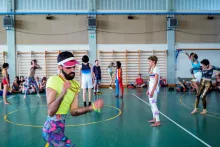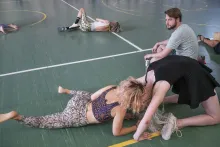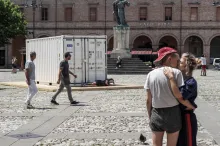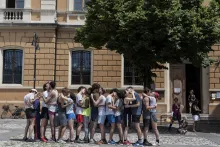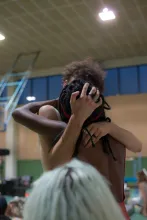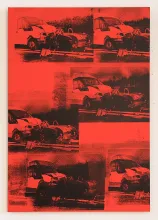KISS
What I was actually trying to do in my early movies was show how people
can meet other people and what they can do and what they can say to each
other. That was the whole idea: two people getting acquainted. And then
when you saw it and you saw the sheer simplicity of it, you learned what
it was all about. Those movies showed you how some people act and react
with other people. They were like documentaries. — Andy Warhol
- Kiss is new because it is now, but also a little while ago.
- Kiss is serialized, screen-printed, a multiplied reproduction of a gesture that propagates virally: a kiss.
- Kiss is a queer temporalities that does not lead to any paradise
- Kiss boycotts the narrative, reorganizing the scenic space according to an idea of comfort and simultaneity.
- Kiss literally inhabits the scene.
- Kiss is not meritocratic.
- Kiss is a multi-organism that moves independently.
- Kiss is a documentary or, if you want, a hairy object.
- Kiss opens the doors and leaves them open so you can enter or exit.
- Kiss can transmit bacteria.
In Kiss economies are a subject for the production of discourse.
- Kiss does not translate but rather converts languages.
The scene is a hyper-object that eats us, discusses us, makes us sleep, makes us dance. Kiss is measured in steps, it measures time by unwinding rolls of film, it becomes an anthropometric system, but precisely because of this it fails every measurement. Bodies and emotions are beyond measurement.
After the experience of the master class at the Biennale Teatro 2018, we are continuing our research by imagining a habitat. This is a systemic entity that generates relationships between living and non-living bodies, rather than organizing the context in which the bodies are placed. The aim of the residency is to investigate how the relationships within the scene between the performers, and between performers and the “outside”, can subvert the principle of an external direction or replace it with alternative scenic systems of self-governance to create the composition.
1964. Shortly after achieving great popularity with his portrait of Marylin Monroe, Warhol released his second anti-film, “Kiss”, 54 minutes of silence accompanied by a long kissing sequence.
The work, with its revolutionary and transgressive character, challenged the laws and the Hollywood system by deploying a human casuistry that was absolutely forbidden at the time: kisses between people of the same sex, or of different ethnicity or race. Can a kiss have the same force today? And in broader terms, can an action still be a manifesto?
This is our starting point to put bodies back into action, trying to write with them, without overwriting, trying to make them react with the present, in a chemical way, like a kiss.
“YOU DON'T ADD PATHOS TO THE WORLD”
References: Andy Warhol Kiss 1963 (film); Sleep 1964 (film); Dance Diagrams; Death and Disaster Series; La filosofia di Andy Warhol. Da A a B e viceversa 1975; J.E. Muñoz, Cruising Utopia. The Then and There of Queer Futurity, NYU Press 2009; Susan Sontag, Note su camp 1964.
performers: Andrea D’Arsiè, Zoe Francia Lamattina, Michela Depetris, Costanza Nani, Beatrice Boschiero, Alex Paniz, Ida Malfatti, Claudia Veronesi, Emilia Verginelli, Clara De Pin, Andrea D’Arsiè, Bruno Camargo, Umberto Ghidini, Brianda Maxciel Carreras Santana, Umberto Zanette, Paolo Vanoli, Nicole Guerzoni, Federico Morini, Giuseppe Maria Martino, Maziar Firouzi, Ilenia Caleo, Silvia Calderoni
based on the imagination of Silvia Calderoni and Ilenia Caleo
Produced by Santarcangelo Festival, CSS Teatro stabile di innovazione del FVG, and Motus with the support of Gucci
and the participation of Dialoghi, Performing Arts Residencies at Villa Manin Project supported by Boarding Pass Plus Danza

